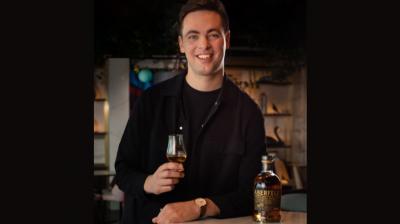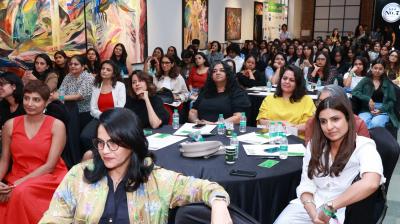Matthew Cordiner, global brand ambassador for single malts at John Dewar & Sons, is a Speyside local with over 17 years of experience in the industry.
He grew up in Craigellachie, a village at the heart of Scotland’s whisky country. His first brush with the craft came on a school trip to the local cooperage, long before he ever imagined a career in spirits.
After university, a summer job as a distillery tour guide at Glenlivet changed everything. That short-term gig led to the Chivas Brothers Graduate Programme, global ambassador roles in Edinburgh, the USA, and South Africa, as well as in-depth technical stints in distillery operations and blending.
In 2018, he joined the Dewar’s Aberfeldy brand home team, which he calls his 'spiritual home', before becoming global whisky ambassador in 2020.
Today, he represents five single malt distilleries on the world stage: Aberfeldy, Aultmore, Craigellachie, Macduff, and Royal Brackla.
We sat down with Cordiner to delve into the heritage, trends, and stories that keep whisky evolving.
Edited excerpts:
How did growing up in Speyside shape your journey and the whisky storyteller you’ve become?
It shaped me more than I can put into words. I moved to Speyside when I was four, and I’ve lived in Craigellachie ever since. The village sits right at the centre of it all. Whisky isn’t just a product; it’s part of the social fabric. Friends, neighbours, family, everyone has some connection to the industry.
Ironically, I never thought I’d work in the whisky industry. I studied classical music because that’s what I loved. But when I came home for the summer and needed a job, I joined Glenlivet as a distillery tour guide. That’s where the switch flipped.
Suddenly, I was meeting people from all over the world who had travelled to Speyside purely for whisky. Other guides were students like me, but some were ex-distillery or warehouse workers with decades of experience. Listening to their stories was like being handed the living history of scotch. That shaped me more than any textbook ever could. I consider myself genuinely lucky to have grown up in such a place.
How has your time in India changed your view of the market and the way Indian drinkers engage with whisky?
It’s been eye-opening. My visit so far has been pretty curated: whisky dinners, cocktail bars, sessions with bartenders, but what stands out is the passion. I knew India loved scotch, but I didn’t realise just how deep that connection runs. The familiarity, the excitement, it’s incredible.
I’ve always said that whisky should be enjoyed however one likes it: neat, on ice, with water, or in a cocktail, as long as one enjoys what’s inside the bottle. On this trip, especially in Mumbai and Delhi, I’ve seen bartenders using our whiskies with real sensitivity. They are building drinks that enhance the character of the spirit instead of hiding it. That’s all a whisky maker can hope for.
Younger drinkers everywhere seem to be drinking less but drinking better. How do you see that shaping the category?
It’s happening globally. People are consuming less overall but choosing higher-quality, more premium brands. That’s obviously encouraging for us because Aberfeldy, Royal Brackla, and Aultmore sit firmly in that space.
But the real shift is in what people value. They’re looking for heritage, craft, and authenticity brands with real stories. Whisky isn’t only about what’s in the glass. It’s the history, the culture, the time invested in making it.
When it comes to heritage and storytelling, packaging becomes crucial. How much does that matter?
Massively. We talk about winning in the last three feet, the moment a person is standing in front of the shelf. Packaging has to speak for the brand in that split-second.
Aberfeldy’s black-and-gold identity, the bottle shape, and the line “gold is in the details” all reflect over 125 years of craft. Every element is intentional.
Royal Brackla takes it even further. The crest isn’t just decoration; it tells the entire story. The date 1812 marks the founding of the distillery. The crown represents the royal warrant granted by King William IV, who declared it the king’s own whisky. The barley symbolises the grain, and the grapes reflect our mastery of sherry cask finishing.
There’s a lot of history on the bottle before you even taste what’s inside.
How well does social media work for the brand, and how do you see your own role online?
It’s huge. Aberfeldy has already felt the impact of digital over the years, and Royal Brackla is building its presence as we speak. Social is where the next generation of whisky drinkers lives. If we want to reach them, we need to show up there with real stories, not sales pitches.
Whisky isn’t just a liquid; it’s an experience. Social media lets us bring people into that world in a way a label alone can’t.
Among Aberfeldy, Aultmore, Craigellachie, Royal Brackla, and The Deveron, which one do you think India hasn’t fully discovered yet?
Aberfeldy already has a strong foothold here. Recently, someone asked me which whisky would be the familiar face at an Indian party. Aberfeldy was the obvious answer, welcoming, flavourful, and layered enough for experienced drinkers too.
Royal Brackla is newer to the market but is gaining traction. With its gorgeous crest and deep dive into sherry cask finishes, it fits beautifully with the Indian palate.
Aultmore, though, is still the hidden gem. Speyside’s best-kept secret. It’s natural colour, non-chill filtered, 46% ABV, a whisky lover’s whisky. I expect we’ll see a lot more curiosity around it in India soon.
Music-led festivals and on-ground culture are huge for spirits right now. How does that help single malts?
Festivals create the right environment for whisky; one is relaxed, open to discovery, and surrounded by people who want to enjoy something special. Tastings take that one step further. Whisky is one of the few spirits with entire festivals dedicated to it, and I spend a lot of time travelling around the world.
In India, I’ve done tasting dinners where we pair specific dishes with different whiskies. When the chef and whisky work together, it turns into a whole experience. For me, it’s always about going beyond the glass and creating real moments people remember.
From a branding point of view, what resonates differently with older and younger audiences?
Older audiences often know exactly what they like. For them, it’s about giving fresh expressions from brands they already trust. And this is where Stephanie Macleod, our master blender and director of blending at Bacardi, comes in. She’s extraordinary.
She was the first woman to ever win 'Master Blender of the Year' at the International Whisky Competition, and now she’s won it six times. She oversees every one of our whiskies across all five single malt distilleries and Dewar’s.
She works with the idea that tradition isn’t the worship of ashes but the preservation of fire. So she honours the past while pushing innovation, exceptional casks, limited editions, and new ideas.
For younger drinkers, the challenge is confidence. Whisky can feel intimidating. Even with my background, I still learn something new every day. My advice is simple: don’t be afraid to ask questions, to explore, to try. We want whisky to feel open and welcoming, not exclusive.
You’re known for immersive whisky education. What does 'immersive' look like in 2025?
Whisky is unlike any other spirit. It has clubs, festivals, societies, dedicated visitor centres, and endless literature. There’s a full culture around it. In 2025, immersion simply means belonging to a community that shares your curiosity.
So much of whisky is tied to moments of celebration. Opening a bottle signals something meaningful. I just want people to feel invited into that world.
In a market where everything calls itself 'premium,' what do you think truly defines premium today?
For us, transparency is everything. John Dewar & Sons is one of the few whisky companies where every single malt carries an age statement. A premium bottle shouldn’t rely only on fancy packaging. If there’s no age statement, the only thing you know is that it’s at least three years old.
With us, if the bottle says Aberfeldy 12, every drop has spent at least 12 years in cask. That’s a promise.
Stephanie Macleod builds these whiskies from a complex mix of casks, and sherry casks, especially, are a huge investment. We don’t cut corners. So real premium comes from time, craft, quality, and honesty. It’s the years in the cask and the integrity behind the bottle.
Is there any global market that you think still has untapped potential?
India, without a doubt. The category is already expanding, but the headroom is massive. Premiumisation and the shift toward drinking less but better work in favour of single malts.
And the competition here is healthy. Some Indian single malts are excellent. They’re not Scotch, and Scotch isn’t Indian single malt; they’re different traditions, but their rise is growing the whole category. There’s space for all of us, and it’s an exciting moment globally.










